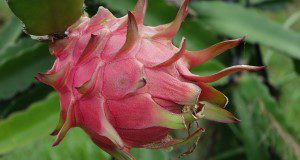Avocado trees are a popular choice for homeowners in Florida, with over 600,000 growing in Florida home landscapes. However, avocado trees as well as others in the Lauraceae family are susceptible to laurel wilt disease, which can kill a tree in as few as three weeks. This new 7-page publication of the UF/IFAS Horticultural Sciences Department provides home owners recommendations for identifying and mitigating laurel wilt disease in the home landscape. Written by Jonathan H. Crane, Jeff Wasielewski, Daniel Carrillo, Romina Gazis, Bruce Schaffer, Fredy Ballen, and Edwards Evans.
https://edis.ifas.ufl.edu/hs1358
Tag: TREC
Stem and Fruit Canker of Dragon Fruit in South Florida
Dragon fruit, also known as pitahaya, pitaya, and strawberry pear, is a group of vine-like, climbing cacti. In south Florida, production of dragon fruit has been steadily increasing since the 2000s, and growers in Florida consider dragon fruit as a potential alternative fruit crop to avocado and citrus, two economically important fruit crops largely impacted by laurel wilt and huanglongbing, respectively. This new 4-page article focuses on the symptomology and epidemiology of stem and fruit canker, a prevailing disease on dragon fruit. Suggested management strategies for the disease are also discussed based on recent studies conducted in south Florida. Written by Cheng-Fang Hong, Shouan Zhang, Romina Gazis, Jonathan H. Crane, and Jeff Wasielewski, and published by the UF/IFAS Plant Pathology Department.
https://edis.ifas.ufl.edu/pp355
Ley del Estado de la Florida para el avalúo tributario de tierras según su uso: Preguntas y respuestas sobre la Clasificación Agropecuaria en el Condado de Miami-Dade (FE895)
 Use-value assessment is the most widely used technique in the United States today for maintaining land in agricultural production. Although general guidelines are provided to Florida counties on the application of the state’s use-value assessment law, counties may vary slightly in the application and determination of the agricultural land’s value. Therefore, it is important for agricultural landowners to understand the guidelines used to determine value in the county where the land is assessed and taxed. This 6-page factsheet applies specifically to Miami-Dade County, Florida. Written by Edward A. Evans, Mauricio Mosquera, Rodney L. Clouser y Jonathan Crane, and published by the UF Department of Food and Resource Economics, August 2011.
Use-value assessment is the most widely used technique in the United States today for maintaining land in agricultural production. Although general guidelines are provided to Florida counties on the application of the state’s use-value assessment law, counties may vary slightly in the application and determination of the agricultural land’s value. Therefore, it is important for agricultural landowners to understand the guidelines used to determine value in the county where the land is assessed and taxed. This 6-page factsheet applies specifically to Miami-Dade County, Florida. Written by Edward A. Evans, Mauricio Mosquera, Rodney L. Clouser y Jonathan Crane, and published by the UF Department of Food and Resource Economics, August 2011.
http://edis.ifas.ufl.edu/fe895
Florida’s Use-Value Assessment Law: Questions and Answers for Miami-Dade County Agricultural Classification (FE890)
Use-value assessment is the most widely used technique in the United States today for maintaining land in agricultural production. Although general guidelines are provided to Florida counties on the application of the state’s use-value assessment law, counties may vary slightly in the application and determination of the agricultural land’s value. Therefore, it is important for agricultural landowners to understand the guidelines used to determine value in the county where the land is assessed and taxed. This 5-page factsheet applies specifically to Miami-Dade County, Florida. Written by Edward A. Evans, Mauricio Mosquera, Rodney L. Clouser, and Jonathan Crane, and published by the UF Department of Food and Resource Economics, April 2011.
http://edis.ifas.ufl.edu/fe890
SL306/TR003 Sunn Hemp – A Cover Crop in Florida
Revised! SL-306 (formerly SS-AGR-96), a 4-page illustrated fact sheet by Yuncong Li, Qingren Wang, Waldemar Klassen, Edward A. Hanlon, Jr., describes this green manure crop that has been grown for centuries in Southeast Asia — origin and distribution, description, uses, production and harvest, and seed production. Includes references. Published by the UF Department of Soil and Water Sciences, August 2009.
http://edis.ifas.ufl.edu/TR003
ENY-852/IN777 The Hibiscus Erineum Mite, Aceria hibisci (Acari: Eriophyidae) a New Introduction in the Caribbean and a Potential Threat to Florida’s Hibiscus
ENY-852, a 5-page illustrated fact sheet by Cal Welbourn, Jose Carlos Rodrigues and Jorge E. Peña, describes this mite pest of hibiscus recently confirmed in the Caribbean — symptoms and identification, dispersal, hosts and control. Includes references. Published by the UF Department of Entomology and Nematology, December 2008.
http://edis.ifas.ufl.edu/IN777
HS1127/HS377 Cashew-Apple Fruit Growing in the Florida Home Landscape
HS-1127, an 11-page illustrated fact sheet by John McLaughlin, Carlos Balerdi and Jonathan Crane, describes this tropical fruit, suitable climate for optimum growth, propagation, production and spacing for the home landscape, soils, planting, care, and pruning, harvest, ripening, storage, and use and nutritional value of the cashew apple. Includes references. Published by the UF Department of Horticultural Sciences, April 2008.
http://edis.ifas.ufl.edu/HS377

